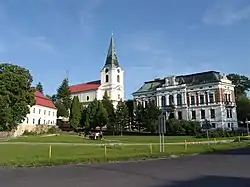Jiříkov | |
|---|---|
 Centre of the town with the Church of Saint George | |
 Flag  Coat of arms | |
 Jiříkov Location in the Czech Republic | |
| Coordinates: 50°59′40″N 14°34′15″E / 50.99444°N 14.57083°E | |
| Country | |
| Region | Ústí nad Labem |
| District | Děčín |
| First mentioned | 1346 |
| Government | |
| • Mayor | Jindřich Jurajda |
| Area | |
| • Total | 13.31 km2 (5.14 sq mi) |
| Elevation | 368 m (1,207 ft) |
| Population (2023-01-01)[1] | |
| • Total | 3,589 |
| • Density | 270/km2 (700/sq mi) |
| Time zone | UTC+1 (CET) |
| • Summer (DST) | UTC+2 (CEST) |
| Postal code | 407 53 |
| Website | www |
Jiříkov (Czech pronunciation: [ˈjɪr̝iːkof]; German: Georgswalde) is a town in Děčín District in the Ústí nad Labem Region of the Czech Republic. It has about 3,600 inhabitants.
Administrative parts
The town is made up of town parts of Filipov, Loučné, Nový Jiříkov and Starý Jiříkov.
Geography
Jiříkov is located about 34 kilometres (21 mi) northeast of Děčín. It lies in the salient region of Šluknov Hook, on the border with Germany. The town is urbanistically fused with the neighbouring German town of Ebersbach-Neugersdorf.
Jiříkov is situated in the Lusatian Highlands. The Jiříkovský Stream flows through the town.
History
The first written mention of Jiříkov is from 1346. In the 15th century, it belonged to the Šluknov estate. The village of Filipov was founded in 1681 by the then-owner of the estate, Philipp Sigmund of Dietrichstein, and named after him. Flax was grown in the vicinity of Jiříkov, which was further processed, but due to the wars, the linen craft began to flourish only from 1751. In 1753, the village was promoted to a market town by Empress Maria Theresa.[2]
The first textile factory was founded in 1807, and during the 19th century Jiříkov was industrialized. In 1873, the railway was opened. The population grew rapidly and in 1914 Jiříkov became a town. In the interwar period, disagreements between the Czech and German populations began, and in 1938 Jiříkov was annexed by Nazi Germany. After World War II, the Germans were expelled and Jiříkov was repopulated by Czech settlers.[2]
Demographics
|
|
| ||||||||||||||||||||||||||||||||||||||||||||||||||||||
| Source: Censuses[3][4] | ||||||||||||||||||||||||||||||||||||||||||||||||||||||||
Transport
There is a road border crossing and railway border crossing Jiříkov / Ebersbach.
Sights
The main landmark of Jiříkov is the Church of Saint George. It was built in the Baroque style in 1724–1728 on the site of an old Gothic church.[5]
References
- ↑ "Population of Municipalities – 1 January 2023". Czech Statistical Office. 2023-05-23.
- 1 2 "Z historie města Jiříkov" (in Czech). Město Jiříkov. Retrieved 2023-05-29.
- ↑ "Historický lexikon obcí České republiky 1869–2011 – Okres Děčín" (in Czech). Czech Statistical Office. 2015-12-21. pp. 9–10.
- ↑ "Population Census 2021: Population by sex". Public Database. Czech Statistical Office. 2021-03-27.
- ↑ "Kostel sv. Jiří" (in Czech). National Heritage Institute. Retrieved 2023-05-30.
External links
- Official website
- . Encyclopædia Britannica. Vol. X (9th ed.). 1879. p. 438.